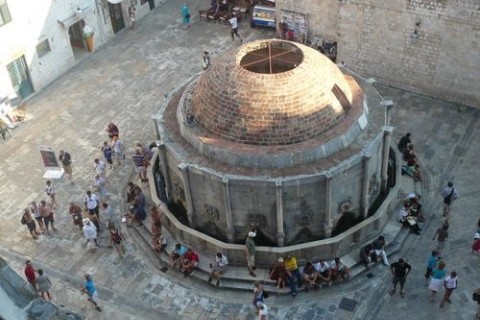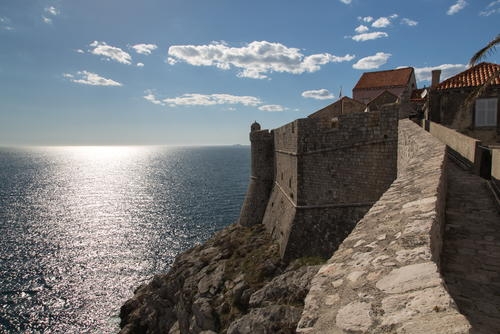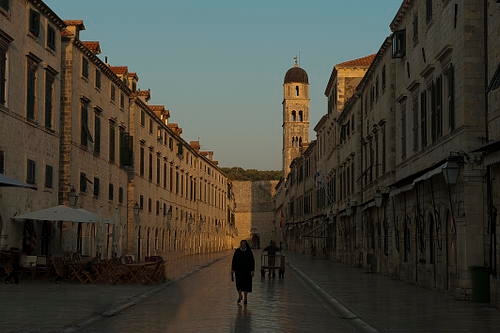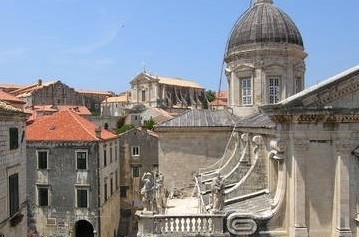George Bernard Shaw was enchanted by this beautiful city, about which he said “those who seek paradise on Earth should come to Dubrovnik”, as well as, famously, describing it as “the pearl of the Adriatic”. It really is a stunning city with an amazing Old Town, which became a UNESCO World Heritage site in 1979.




The history of Dubrovnik is remarkable. An independent, merchant republic for 700 years (abolished by Napoleon in 1806), it traded with Turkey and India in the East (with a consul in Goa, India) and had trade representatives in Africa, in the Cape Verde Islands. It even had diplomatic relations with the English court in the Middle Ages. (There is a letter from Elizabeth I on display in the City Museum in Dubrovnik). Its status was such that powerful and rich Venice was envious of this Croatian-Slav city.
Early History of Dubrovnik
The main history of Dubrovnik usually concentrates on a small settlement on the site of Dubrovnik in pre-historic times; this settlement, in fact, was on an island called Laus which was, at that time, separated from the mainland by a marsh. There was also a larger Greek settlement nearby in what was called Epidauros (present-day Cavtat).
An invasion by Slavs in the 7th century destroyed Epidauros and other communities in the area, causing inhabitants to flee to Laus. Laus eventually changed to Raus which in turn became Ragusa – which is the historic name for Dubrovnik. Around this time, Dubrovnik itself was founded by Croats (the name stemming from dub which means oak and dubrava which means wood – unsurprisingly, the settlement was by an oak forest).
Ragusa and Dubrovnik eventually merged when the marshland between them was filled in.
Another theory about Dubrovnik’s history which is gaining weight is that there was in fact a large Greek settlement where Dubrovnik is situated today and that the city in fact has Greek origins.
Growth and prosperity
Dubrovnik expanded considerably from the 9th century onwards and as part of the Byzantine Empire, so by the 12th century it was even considered as somewhat of a threat to Venice and its Republic. It came under attack from Venice, and from 1205 to 1358 fell under its rule.
The old town was completed in the 13th century and remains virtually unchanged to the present day. Tall ramparts surround it and there are only two entrances to the old town which lead to Stradun, the city’s promenade.
In 1358 the Treaty of Zadar saw Dubrovnik cease being under Venice’s rule and instead become Croat-Hungarian, although it had a great deal of independence.
From the 13th century onwards, Dubrovnik experienced a number of important developments which increased its prominence. The Statutes of 1272 laid the groundwork for political and legal life in the city. From the 14th century trade with the local region flourished and the city also prospered industrially and culturally. Dubrovnik had a number of advanced establishments for that time – a pharmacy was opened in 1317 and an orphanage in 1432.
Fall of the Republic
Dubrovnik was hit by an earthquake on 6 April 1667, which killed about 5,000 inhabitants and destroyed much of the city, although the city walls remained standing. The city was much weakened, and when in 1806 Napoleon entered Dubrovnik there was little resistance. The Republic of Ragusa was officially dissolved in 1808 but, after Napolean’s fall, Dubrovnik became part of the Austro-Hungarian Empire in 1815.
Dubrovnik in Yugoslavia and Croatia
After World War I, Dubrovnik became part of Croatia which itself was part of the Kingdom of Serbs, Croats and Slovenes which became Yugoslavia after World War II.
Dubrovnik was subjected to considerable shelling by Serbs during the war in 1991/2 in a siege that lasted seven months. The Old Town suffered considered damage, but was quickly restored to its former beauty.
As Dubrovnik is the most southern city in Croatia, the most practical way to reach it is to do so by air, especially as there’s a very good frequency of flights during the summer months.
Here’s information on the best ways of getting to Dubrovnik, including flights from the UK, Ireland and Europe, ferry from Italy, and air, bus and ferry (but not train!) from the rest of Croatia.
Flights from the UK & Ireland
Year-round flights to Dubrovnik
British Airways are the only airline to operate year-round flights from the UK (London Gatwick) to Dubrovnik, with daily flights operating from March to late summer, and two flights a week at other times of the year.
Summer flights to Dubrovnik
During the summer months, Easyjet have several flights a week from both London Stansted and London Gatwick to Dubrovnik (with daily flights from the latter airport from mid-May to mid-October). They also have twice-weekly flights from Edinburgh.
Norwegian operate two flights a week from London Gatwick to Dubrovnik from early April to the end of October.
Aer Lingus have several flights a week from Dublin from the end of March to the end of October.
Croatia Airlines also operate direct flights from London during summer, and there are further options via Zagreb.
Please see our Flights to Croatia section for the latest flight details, and full dates of operation for all of the flights mentioned above.
Getting to Dubrovnik – Flights from Europe
N.B. The following routes are all direct. You may also be able to reach other destinations in the following countries with a stopover – for example, Germanwings offer flights from a number of other destinations in Germany via stopovers at the cities listed below. Many of the flights listed below operate only during summer.
Flights from Austria to Dubrovnik
Flights from Belgium to Dubrovnik
Flights from the Czech Republic to Dubrovnik
Flights from Denmark to Dubrovnik
Flights from Finland to Dubrovnik
Flights from France to Dubrovnik
Flights from Germany to Dubrovnik:
Flights from Greece to Dubrovnik
Flights from Italy to Dubrovnik
Flights from Israel to Dubrovnik:
Flights from Latvia to Dubrovnik:
Flights from the Netherlands to Dubrovnik:
Flights from Norway to Dubrovnik
Flights from Serbia to Dubrovnik
Flights from Spain to Dubrovnik
Flights from Sweden to Dubrovnik:
Flights from Switzerland to Dubrovnik
Getting to Dubrovnik – Flying via Zagreb
Croatia Airlines have several daily flights a week from Zagreb to Dubrovnik. If you can’t find a suitable flight direct to Dubrovnik, see if you can fly/travel to Zagreb and then get a Croatia Airlines flight from there.
If you’re travelling during winter, the above route via Zagreb is also suitable to give you a few more options.
More about flight schedule on following link…
It’s very easy to walk in and around Dubrovnik’s Old Town; its size means that you can get from one gate to another, or from one of the entrances to the “edge” of the walls in no time at all! It is, however, the actual exploring of the fascinating Old Town that will keep you more than occupied for a number of days.
Sightseeing in Dubrovnik – The Main Sights
You will probably enter the Old Town through Pile Gate – in front of you is Stradun. Here you will find the Onofrio Fountain, built in 1438. On the right is the Franciscan Monastery, with one of the oldest functioning pharmacies in Europe, in operation since 1391. At the other end of the Stradun, you will find the locals’ favourite meeting place, the Orlando Column, with the nearby Sponza Place and the baroque Church of St. Blaise. Here also is the Rector’s Palace, built in 1441, which is now a city museum packed with valuable and historic exhibits.
Opposite the palace through a narrow street is a square, Gunduliceva Poljana, which is the site of the busy morning market. In the same square is the Jesuit Monastery that is from the early 18th century. From here you can head for the little old town port and visit the city walls which encircle the city and which have been remarkably preserved.
Sightseeing in Dubrovnik – Stradun
Looking down on Stradun, with the Franciscan Monastery on the left
Stradun/Placa
Stradun, also called Placa, runs from Pile Gate to Ploce Gate. The paving stones were laid in 1468. At one end (at Pile Gate) is the Onofrio Fountain whilst at the other end is the Orlando Column, a favourite meeting place for locals.
Dubrovnik Old Town Walls
The city walls were originally constructed in the 10th century, although fortified considerably in 1453. They are 3m thick along the sea wall, and 6m thick inland. The Old Town has fortresses at its four corners, which are the Minceta Tower, Revelin Fortress, St John’s Fortress, and Bokar Bastion.
Sponza Palace
Constructed in 1522 – a survivor of the 1667 earthquake – the Palace has had a variety of uses over the centuries, including where the Republic of Ragusa minted its currency. These days, it houses the city archives upstairs whilst downstairs is used for exhibitions and during the Summer Festival. It also houses a permanent exhibition named “Memorial Room of the Dubrovnik Defenders”, a memorial to those Dubrovnik citizens who lost their lives during the war between 1991 and 1995.
Pile Gate
From the 15th and 16th centuries, the western gate was and is the traditional entrance to the Old Town. The gate contains a statue of St Blaise, Dubrovnik’s patron saint.
Sightseeing in Dubrovnik – Onofrio’s Fountain
Onofrio’s Large Fountain (Great Onofrio Well)
Originally constructed in 1438 by Italian architect Onofrio della Cava, the fountain was partially damaged in the 1667 earthquake and further during the war in 1992 (although it was rapidly restored). The fountain was part of the city’s water mains constructed in the 15th century which brought water from the Dubrovacka River 12km away.
Ploce Gate
The eastern entrance to the Old Town, this gate stems from the 15th century.
Franciscan Monastery
The main part of the monastery was destroyed in the earthquake of 1667 and was rebuilt. The monastery also contains what is thought to be the oldest pharmacy/apothecary in Europe, from 1316/7, and a calming cloister from 1360.
The Church of St Blaise (Crkva svetog Vlaha in Croatian)
A Baroque church, built between 1705 and 1717, which features a silver statue of the Dubrovnik patron saint on the altar, holding a model of the city, which is brought out each year during the Festival of St Blaise. The stained glass windows of the church are relatively recent, having been added in the 1970s.
The Cathedral
The cathedral currently standing dates from 1673, designed by Roman architect Andrea Buffalini to replace the original 12th century cathedral which was destroyed by the earthquake. The cathedral includes a Assumption Of Our Lady/The Virgin painting/polyptych that has been assumed to have been painted by Titian. The Treasury of the cathedral is home to the skull of St Blaise which has been encased in a jewel-encrusted crown. Another earthquake in 1979 saw cause to dig drains beneath the cathedral; these excavations uncovered a Romanesque cathedral beneath the current one. Further digging, uncovered another church underneath this one, dating from about the 6th century.
Rector’s Palace
Mainly designed by Onofrio della Cava – who also designed Onofrio’s fountain – the rector’s palace has a somewhat turbulent history. The original building (from 1200) was completely destroyed in 1435 by a gunpowder explosion; this one, from the same year, saw the second floor also completely destroyed by an other explosion in 1463. Further damage was caused by the 1667 earthquake. The result of all this tumult meant the resulting building is built in various styles and by various designers. Currently home to the city museum, the palace was of course home to the Rector, who acted as a kind of figurehead of the Republic of Ragusa with little actual power.
Dubrovnik Cable Car
One of Dubrovnik’s famed attractions used to be its cable car – built in 1969 – which rose up to the top of Mount Srd above the city, giving visitors a chance to take in some (even more) spectacular views of the Old Town and the shoreline. Sadly, the cable car was completely destroyed during the war in the early 1990s and was never repaired…until 2010! The service has now been fully restored with entirely new equipment and is now an absolute must for visitors once again. A journey to the top of Mount Srd takes only 3 minutes, and once there you can take in the views whilst enjoy a snack, or something more, at the cafe or restaurant at the top.
Sightseeing in Dubrovnik Tip – Purchase a Dubrovnik Card!
If you’re planning on visiting a number of museums in Dubrovnik, purchasing a Dubrovnik Card is a must. The card gives you entry into many of the city’s museums, as well as allowing you to use the city’s public bus system for free. You can purchase either a one-day card for 130 Kunas, a three-day card for 180 Kunas or a one-week card for 220 Kunas – and there’s even further savings if you pre-order a card online. More info at Dubrovnik Card.
The area code is 020.
The tourist Office is at Svetog Dominika 7, 20000 Dubrovnik
Tel: +385 (0)20 312 011
E-mail: info@tzdubrovnik.hr.